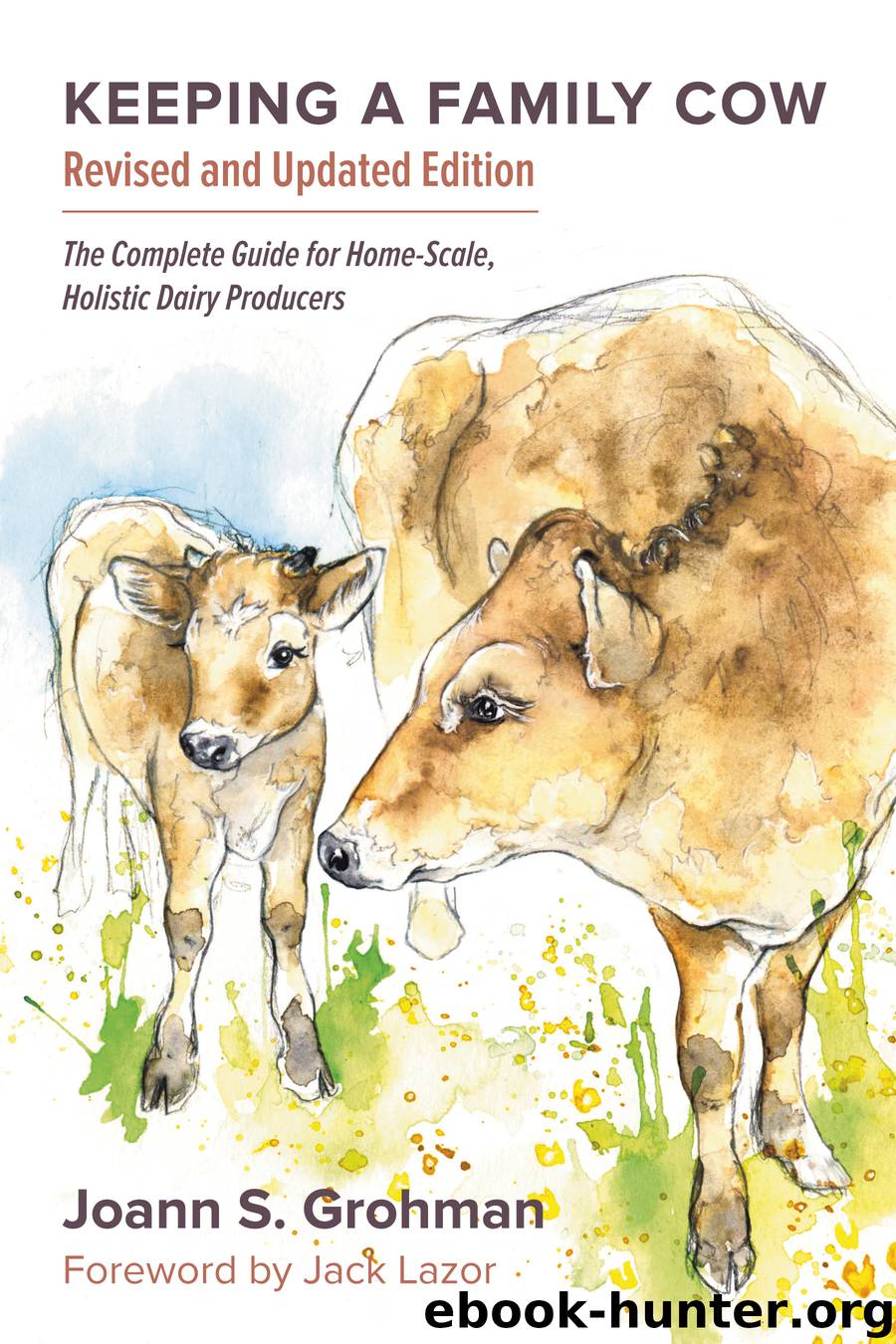Keeping a Family Cow by Joann S. Grohman

Author:Joann S. Grohman
Language: eng
Format: epub
ISBN: 978-1-60358-479-1
Publisher: Chelsea Green Publishing
Published: 2013-10-09T04:00:00+00:00
The typical ruminant is an animal that survives by fleeing from danger. It is a prey species. It goes out in an open, grassy area to graze and eats as rapidly as possible, swallowing its food without chewing. Then it goes off to a safe place and brings up the undigested grass one mouthful, or cud, at a time and chews it thoroughly before swallowing it again. The cud is composed of fibrous stringy material that floats in the rumen like a mattress. Chewing adds saliva and breaks cell walls, releasing carbohydrates, which provide a quick meal for the microorganisms, which then attack the cellulose when the cud is swallowed.
The microorganisms are able to chemically break down the fiber and use its constituents as building blocks for amino acids. These bacteria within the rumen create “from scratch” all the essential amino acids; in other words, they create complete animal protein. They assemble their own cell walls and cell contents from these amino acids.
This complete protein, in the form of a soup of living and dead bacteria and protozoa, passes along into the ruminant’s additional stomach compartments for further processing and finally into the abomasum or true gut, where it receives digestion and absorption similar to our own. When food reaches the abomasum, the cow ceases to be a vegetarian; her rumen provides her with a high-protein diet. This is not incomplete soybean or peanut or wheat protein; it is complete protein obtainable to the rest of us only by eating eggs, meat, fish, or other living creatures or by drinking milk.
Every animal requires complete (animal) protein from some source in order to maintain a breeding population. It bears repeating: all animals except ruminants and others with a specialized organ full of cellulose- splitting bacteria must obtain their complete protein by eating other animals or drinking milk. Thus, the bacteria inside an insect digests the cellulose, perhaps a fish eats the insect, then a duck eats the fish, somebody eats the duck, and so on up to the ultimate consumer. But the complete protein was derived initially from synthesis by bacteria. The creatures higher up the food chain accumulate complete protein; they all have to eat other animals to get theirs. Then they pass it along when they in turn are eaten.
The cow proceeds efficiently from resident bacteria directly to her complete (animal) protein diet without the intermediaries necessary elsewhere in the food chain. Because of the extremely simple dietary requirements of rumen bacteria (any fibrous material), the extremely high nutritional value of milk, and the negligible net energy loss that the process requires (it can approach zero), the dairy cow is uniquely efficient among animals, and impressive by comparison with any system. She produces an easily obtainable food of the highest possible nutritional quality right on site from coarse plants of no use to anybody else. The only thing lower on the food chain than a cow is bacteria.
Note that rumen bacteria do not digest one type of fiber: lignin. The large amount of lignin in wood makes sawdust of little value in ruminant feeding.
Download
This site does not store any files on its server. We only index and link to content provided by other sites. Please contact the content providers to delete copyright contents if any and email us, we'll remove relevant links or contents immediately.
| Automotive | Engineering |
| Transportation |
Whiskies Galore by Ian Buxton(41872)
Introduction to Aircraft Design (Cambridge Aerospace Series) by John P. Fielding(33064)
Small Unmanned Fixed-wing Aircraft Design by Andrew J. Keane Andras Sobester James P. Scanlan & András Sóbester & James P. Scanlan(32743)
Craft Beer for the Homebrewer by Michael Agnew(18140)
Turbulence by E. J. Noyes(7935)
The Complete Stick Figure Physics Tutorials by Allen Sarah(7307)
Kaplan MCAT General Chemistry Review by Kaplan(6866)
The Thirst by Nesbo Jo(6826)
Bad Blood by John Carreyrou(6543)
Modelling of Convective Heat and Mass Transfer in Rotating Flows by Igor V. Shevchuk(6391)
Learning SQL by Alan Beaulieu(6209)
Weapons of Math Destruction by Cathy O'Neil(6142)
Man-made Catastrophes and Risk Information Concealment by Dmitry Chernov & Didier Sornette(5921)
Digital Minimalism by Cal Newport;(5661)
Life 3.0: Being Human in the Age of Artificial Intelligence by Tegmark Max(5474)
iGen by Jean M. Twenge(5366)
Secrets of Antigravity Propulsion: Tesla, UFOs, and Classified Aerospace Technology by Ph.D. Paul A. Laviolette(5309)
Design of Trajectory Optimization Approach for Space Maneuver Vehicle Skip Entry Problems by Runqi Chai & Al Savvaris & Antonios Tsourdos & Senchun Chai(5011)
Pale Blue Dot by Carl Sagan(4908)
